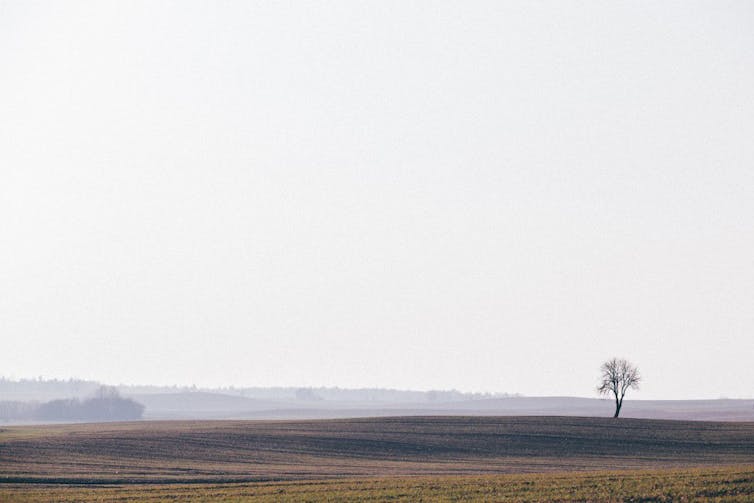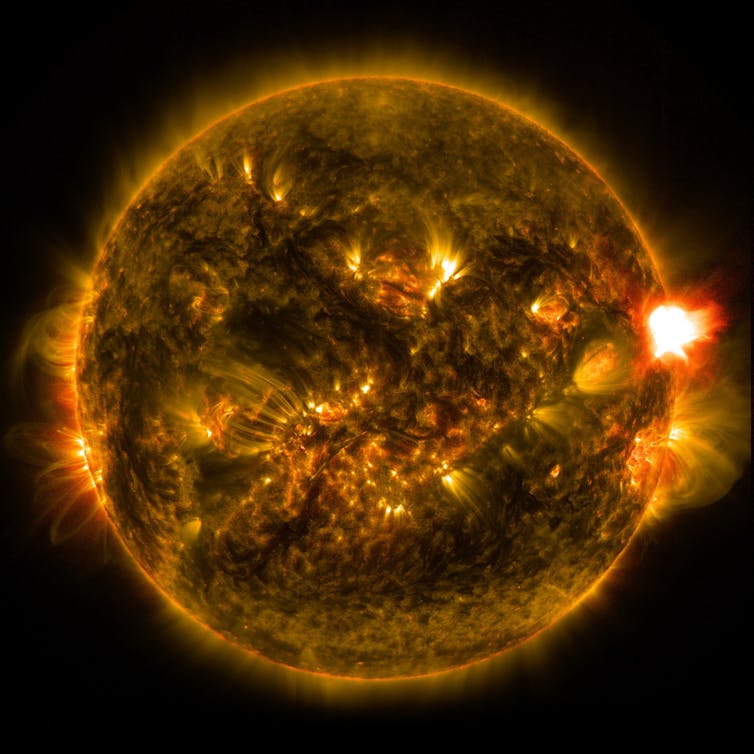A group of 60 scientists called for a moratorium on solar geoengineering last month, including technologies such as stratospheric aerosol injection (SAI). This involves a fleet of aeroplanes releasing aerosol particles – which reflect sunlight back to outer space – into the atmosphere, cooling down the Earth.
SAI might make the sky slightly whiter. But this is the least of our concerns. SAI could pose grave dangers, potentially worse than the warming it seeks to remedy. To understand the risks, we’ve undertaken a risk assessment of this controversial technology.
A cooler Earth means less water would be evaporating from its surfaces into the atmosphere, changing rainfall patterns. This could produce ripple effects across the world’s ecosystems – but the exact nature of these effects depends on how SAI is used. Poor coordination of aerosol release could lead to extreme rainfall in some places and blistering drought in others, further triggering the spread of diseases.
SAI could also make natural catastrophes worse than they currently are. A volcanic eruption, like that of Iceland’s Eyjafjallajökull volcano in 2010, could naturally cool the Earth as plumes of ash block sunlight from reaching the planet’s surface. If this happened while SAI was deployed, it would have to be urgently adjusted (not an easy feat) to avoid overcooling one hemisphere and producing extreme weather patterns as a result.
Similarly, although nuclear war may seem unlikely, global nuclear capabilities continue to grow, and bad political decision-makers are in no short supply. A “nuclear winter”, during which global temperatures drop for years due to soot clouds from nuclear-triggered fires, could be deepened by SAI.

Termination shock
SAI would likely rely on aerosols being consistently sprayed into the atmosphere by a fleet of aeroplanes, as the particles have a half life of approximately eight months. Satellites would be needed to coordinate these efforts and help monitor any atmospheric changes.
Any disaster severe enough to permanently disable these systems could trigger a “termination shock”. If an SAI system effectively “hiding” global warming were suddenly removed for an extended period, the Earth could heat up by multiple degrees in a matter of decades. If we’re already seeing fires, heatwaves, and flash floods across the world with around 1.1°C of warming since 1850, just imagine what warming of 3-4°C would do.
There are numerous ways in which an SAI system could be disrupted. An unprecedented explosion of solar matter, related to a solar flare, could knock out the world’s electrical systems by smashing into the Earth’s magnetic field. This could damage the aviation and satellite systems needed for SAI.
Hoping that catastrophes will simply not occur in the coming century would also be a mistake. One model estimating the likelihood of nuclear war between Russia and the US puts that probability at 0.9% per year. Estimates of large-scale space weather events range from 0.46% to 20.3% per year.

SAI could also be an attractive target for cyberattacks. In 2019, a group of hackers named DarkSide took the US oil company Colonial Pipeline hostage by launching a ransomware attack on their computer systems. Fearing widespread fuel shortages across the US, operators were forced to pay £3.7 million to DarkSide in exchange for reactivating their systems.
And in 2000, the automated sewage system in the small coastal Australian region of Maroochy released hundreds of thousands of gallons of sewage into the sea. These “leaks” were actually caused by a single disgruntled ex-employee of the company that installed the system. An international infrastructural system masking global warming would attract more reasons for controversy, have a larger workforce than a local sewage system, and could likely fetch an even higher payoff.
Political mess?
Of course, it’s possible that SAI will end up being used responsibly. But if one thing goes sufficiently wrong – such as one unpredictable solar storm taking place – the hidden risks of SAI could be unleashed. Predictions of SAI’s average or “most likely” outcomes are generally fine. But although far less likely, SAI’s worst case scenarios could be calamitous.
If SAI is used sparingly to offset a smaller amount of warming, any negative impacts would be minimised. Most SAI models assume ideal conditions, where a cooperative group of countries rationally and carefully deploy SAI. Unfortunately, international politics is messy.
A small group of countries that prefer a cooler Earth could start to use SAI without international agreement. Yet there is little research on what the effects of this more disorganised use of SAI might be.
In an ideal world, those governing SAI would ensure that its infrastructure is resilient against catastrophes, operated cooperatively between countries, has extensive backups and is closely monitored for the duration of SAI deployment (likely decades and potentially over a century). And to ensure we don’t get trapped into relying on SAI indefinitely, we’ll still have to reduce greenhouse gas emissions to net zero, as well as removing excess emissions from the atmosphere.
But assuming this kind of governance would be naive. Just consider the pandemic. From underinvesting in COVID testing and vaccine development to placing misguided trust in herd immunity, policymakers have not proven reliable decision-makers. Imagine the conflict over placing a chemical mask over the Earth.
SAI could become a highly politicised issue, with changes in SAI use driven by political swings rather than sound science. And the fossil fuel industry and its supporters may well develop a vested interest in using SAI to delay the use of renewables.
Is SAI worse than climate change? We’re still uncertain. What we can say is this: in a world where things don’t go wrong, SAI is a prudent response to the climate crisis. But we live in a world of complexity and chaos, where relying on SAI would be deeply unwise. By tightly coupling the climate system to the global economic and political system, using SAI would be hoisting up a planetary Sword of Damocles.
- Postdoctoral Research Associate in Existential Risk, University of Cambridge
- is a PhD Scholar in Climate Governance, Australian National University
This article first appeared on The Conversation




